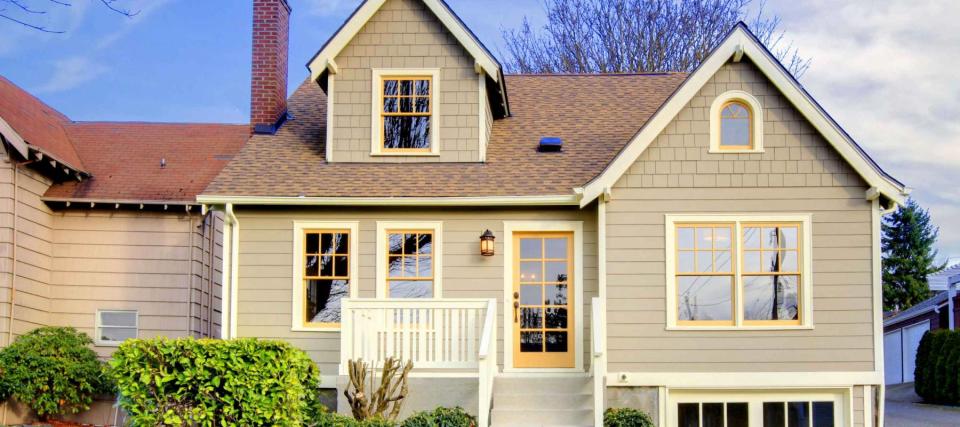How a 'piggyback mortgage' can give you the boost you need to buy a home

It’s a common scenario in today’s sizzling housing market: You’ve found your dream home, but it will stretch your budget to the absolute max.
And, when it's time to get mortgage financing, you find you don't have the cash to make a down payment of at least 20% of the home's purchase price. And that means you may be forced to pay for what’s known as private mortgage insurance, which is coverage that will protect your lender if you default on your loan.
You "may be" forced to pay for it — not "will be" — because there's a workaround, another option that could allow you to buy a house and take advantage of today’s tantalizingly low mortgage rates without having to bring 20% in cash to the closing. It's called a piggyback mortgage loan.
What is a piggyback mortgage?

When you use a piggyback loan, you take out two mortgages instead of one. Typically, the first loan is equal to 80% of the home’s purchase price and the second is equal to 10%. The remaining 10% is what you'll need to bring to the table as a down payment.
The second loan "piggybacks" off the first, and allows you to avoid private mortgage insurance, commonly known as PMI.
For example, let's say you’ve set your sights on a $350,000 house. A 20% down payment — enough to keep you clear of PMI — would total $70,000. It would be a tall order to come up with that much cash if your savings are meager and you don't have wealthy parents to float you the money.
Here's how a piggyback loan would come to your rescue: You'd take out a first mortgage for $280,000, or 80% of the purchase price. Then, you'd take out a second, piggyback loan for $35,000, representing another 10%. The remaining 10% — another $35,000 — is what you’d contribute as the down payment.
That’s a much more digestible amount than $70,000.
While this type of financing can help if you don’t have a ton of cash in the bank, you need to understand both the pros and the cons.
First, the advantages of a piggyback loan

Home prices have been skyrocketing lately, putting a 20% down payment out of reach for more and more would-be homebuyers.
The U.S. median selling price of a previously owned home in April was a record-high $341,600, up a sharp 19.1% from a year earlier, according to the National Association of Realtors. The median price is right in the middle: Half of homes sold for less, but half sold for more than $341,600.
Again, the most obvious advantage of a piggyback loan — also known as an 80-10-10 — is that you can make a down payment of less than 20% of a home's purchase price while saving yourself from PMI, which can be expensive.
The insurance premiums will vary based on the size of your mortgage and the strength of your credit score, but research from the Urban Institute shows you will usually pay between 0.58% and 1.86% of your loan amount per year. That means on a $300,000 mortgage, PMI could cost as much as $5,580 annually.
Another benefit of an 80-10-10 loan is it could help you avoid taking out a jumbo loan, if you're buying a higher-priced home. Jumbo mortgages exceed limits set by government-sponsored mortgage companies Fannie Mae and Freddie Mac and can come with higher interest rates.
When you're using a piggyback loan structure, the second loan is usually a home equity loan or home equity line of credit (HELOC), the Consumer Financial Protection Bureau says. The interest rate on a HELOC is typically tied closely to the prime rate.
And, the disadvantages of a piggyback loan

Before using a piggyback loan to finance your home, be sure to run all the numbers. Since you’ll be taking out two mortgages, you likely will have to pay two sets of closing costs — which typically total up to 5% of each loan amount.
Plus, the second mortgage is likely to have a higher interest rate.
Rates on home equity loans and lines of credit are stiffer than the rates on conventional 30-year fixed-rate mortgages — which are currently averaging just 2.95%, according to Freddie Mac.
And if you ever decide to refinance your primary loan at some point, you may have to pay off the secondary, piggyback loan first.
How to prepare your finances to qualify

In order to qualify for a piggyback loan, you’ll need to make sure your finances are in good shape.
You might be able to land the first loan with a credit score as low as 620, but home equity lenders often demand higher scores. If you’re not sure whether your credit is good enough, it’s easy these days to check your credit score for free.
A lender also will also look closely at how much debt you're already carrying — and probably won't feel very confident if you're burdened by multiple high-interest debts. You might consider rolling your balances into a single, lower-interest debt consolidation loan.
Whether you’re looking for a piggyback loan or a more traditional arrangement, one of the best ways to get an interest rate that fits your budget is by reviewing several loan offers side by side. Studies from Freddie Mac and others have found you’ll save thousands in the long run by comparing rates from at least five lenders.
